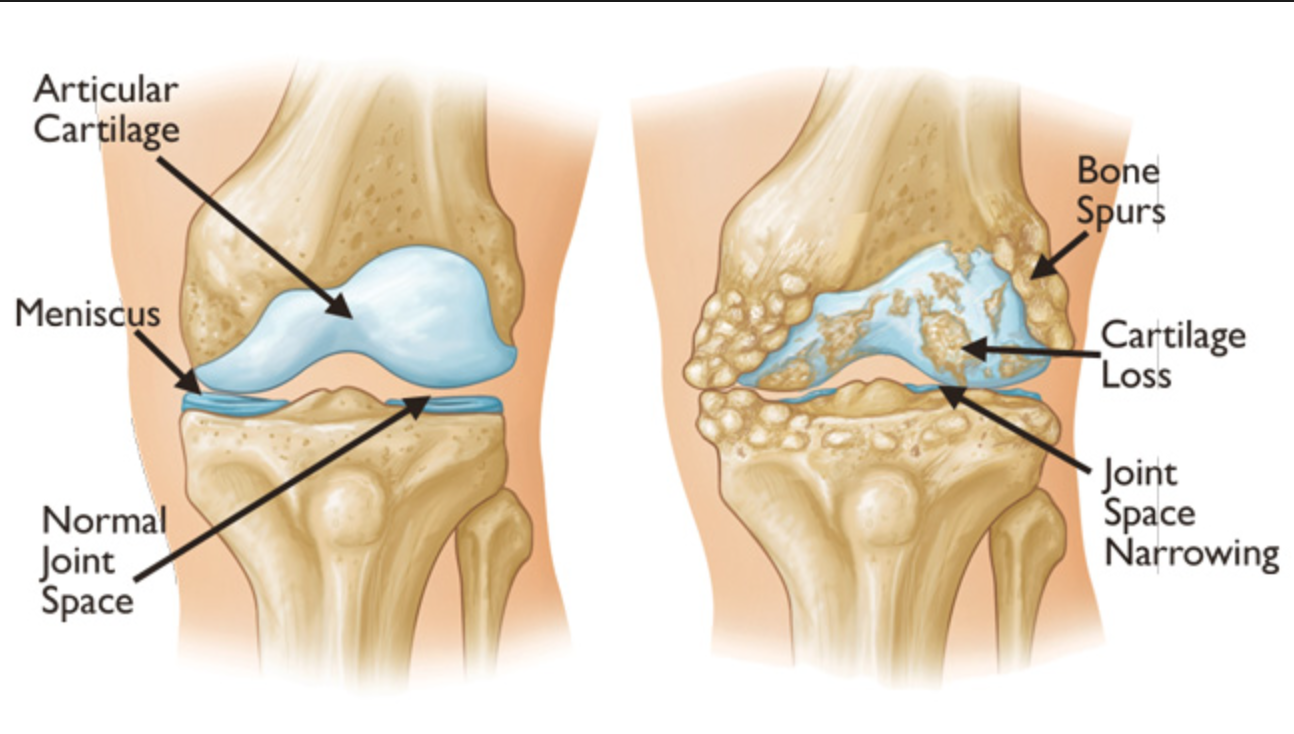Osteoarthritis (OA) is often referred to as degenerative joint disease. When two bones meet at a joint, the ends of the bones are covered by a rubbery material called cartilage. The purpose of this cartilage is to provide a smooth gliding surface for the joint. For many reasons including age, weight, genetics, trauma, and others factors cartilage breaks down. When this happens bone is exposed directly to bone resulting in friction, pain, and swelling.
Non-medicinal approaches to the treatment of OA.
- Age is the strongest risk factor, unfortunately we can’t do much about that one.
- Obesity – The strongest modifiable risk factor is obesity. One study showed that over a 10 year period, a 10 pound weight loss in obese patients resulted in a 50% reduction in the development of osteoarthritis. For weight bearing joints such as the hips and knees the more you lose the better the results. A consistent diet and exercise program shows the most benefit.
- Rest – Usually pain worsens after prolonged use. For an acute episode of pain related to OA, rest for 12-24 hours can decrease the pain. Prolonged rest however will lead to muscle atrophy and decrease joint mobility which will worsen the problem.
- Physical Therapy – Function and pain scores improve with well designed physical therapy programs. Flexibility improves and improvements in muscle strength that help support joints are seen.
- Canes and walker reduce joint forces at the hip by 50%.
- Padded shoes – Wearing appropriately padded shoes and improving quadricep strength decreases foot force while walking and therefore force transferred to the knees and hips.
- Lateral shoe wedge insoles – Data is inconsistent that these help.
- Knee braces – The most common form of knee OA predominately affects the inside or medial joint space. Braces designed to increase the medial space of the knee, known as valgus braces, can provide relief for some people. Patients may also obtain symptom relief with simple neoprene elastic sleeves. Trying these simple elastic sleeves is relatively cheap and simple. Valgus braces are much more expensive and typically need to be custom fit.
- Knee taping – Taping the knee to offload the joint space can be effective in some people if done weekly.
- Exercise – Most studies support the use of exercise as part of a multifaceted approach. A well designed exercise program can reduce pain and improve function. Knees seem to respond better to exercise than hips. Mild OA responds better than Moderate-severe OA. Even in the Moderate-severe OA patients’ Quality of Life Scores are higher in those who exercise regularly. Emphasis should be placed on muscle strengthening programs and on low-impact aerobic exercises such as swimming, bicycling, walking, and Tai-chi. A good general rule of thumb is to warm up with low intensity aerobic exercise for a few minutes followed by stretching. Done prior to more intense exercise this promotes circulation and limits stress across joints. Moderate-severe OA patients may start with exercise designed to improve range of motion and isometric exercises. Isometric exercises are exercises where contractions are held while the joint remains motionless. As one’s strength improves the goal is to progress to isotonic exercises (strengthening exercises that involve active range of motion) and aerobic conditioning. With more severe OA low impact exercises are preferred. Exercises that are designed to reduce the impact on joints such as swimming and water aerobics are extremely helpful. Our gym, Life Changing Fitness through its association with Physical Therapy Services, uses an anti-gravity treadmill using technology created by NASA to unweight people while walking on a treadmill. Check it out at http://www.alterg.com.
(A well designed exercise program has many benefits including: decreased disability, improved overall health, improved longevity, increased bone strength, decreased risk of developing Coronary Artery Disease prematurely, improved Psychologic health therefore coping mechanisms, and improved socialization.)
11. Moist superficial heat can increase pain threshold and produce pain relief by acting on nerve endings and decrease spasms. I recommend not exceeding 20 minutes at a time. A good protocol to follow is 20 minutes with a heating pad or warm water bottle alternating with 20 minutes of no heat.
12. Superficial cooling can also decrease muscle spasms and increase pain threshold as well. Studies are limited, however.
Future articles will look at dietary supplements, vitamins, medications, and surgical remedies.
Here’s to the Journey!

